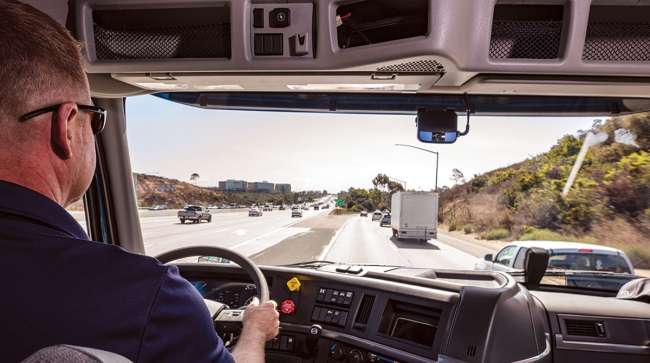Staff Reporter
Safety Practices Can Offset Rising Insurance Rates, ATRI Study Says

[Stay on top of transportation news: Get TTNews in your inbox.]
Motor carriers can offset the rising cost of insurance premiums by continuously improving their overall safety practices and expanding use of smart technology, a new report said.
According to data included in “The Impact of Rising Insurance Costs on the Trucking Industry,” released Feb. 17 by the American Transportation Research Institute, the rate of insurance cost hikes from 2009 to 2018 “far exceeds” the nominal rate increase in truck-involved crashes, even though annual premiums factor in past crash history.
During the last decade, per-mile insurance premium costs jumped 47%, from 59 cents to 87 cents, the report noted. ATRI surveyed 82 motor carriers that collectively operate 94,555 truck tractors, straight trucks and specialty trucks.
ATRI Rising Insurance Costs... by Transport Topics
Small fleets, those with one to 20 trucks, had premiums two times higher per mile than large fleets (101 to 1,000 trucks), which paid almost twice as much per mile as very large fleets with over 1,000 trucks.
“The largest percent increase in premium costs per mile was seen in very large fleets,” the report stated. “Even though very large fleets have the lowest premium cost per mile, this large percent increase poses significant challenges for operational planning.”
Between 2018 and 2020, 90% of carriers saw their premiums increase even though only 12.5% had increased their insurance coverage during that time. And 18.3% of carriers — mainly from large and very large fleets — saw their premiums soar 50% despite no increase in their coverage.
Carriers operating in the Northeast paid the highest insurance premiums, while those in the Midwest paid the lowest. The Southeast region of the country reported the largest increase compared to other areas.
Rate increases also were tied to economic conditions in the insurance industry, such as a 50% jump from 2015 to 2019 in incurred losses for insurers of commercial vehicles. ATRI found that loss ratios were higher in states with more truck registrations being more prone to litigation, such as Texas.
FOR IMMEDIATE RELEASE FROM ATRI: New #ATRI Research Evaluates Motor Carrier Strategies for Responding to Rising #Insurance Costs https://t.co/g2b8yDvK0F #TruckingResearch #Trucking — ATRI (@Truck_Research) February 17, 2022
The report noted that the financial impact litigation can have on insurance companies is passed along to motor carriers.
“External factors that go well beyond carrier safety force commercial trucking insurance costs to increase, which then requires carriers to redesign their business strategies,” said Dale Porfilio, chief insurance officer of the Insurance Information Institute. “The higher premiums ultimately tend to be passed along to consumers in the form of higher prices for goods and services. ATRI’s study corroborates the Triple-I’s research on rising insurance costs and social inflation — that increased litigation and other factors dramatically raise insurers’ claim payouts.”
ATRI said litigation payouts averaged between $406,386 and $449,792 for small verdicts and settlements in the trucking industry. In fact, lawsuit-related factors — rather than truck crashes — had a statistically significant impact on payment amounts, especially in highly litigious states such as California, Michigan, New Jersey and North Carolina, where the average lawsuit payment was 50% higher than the national average.
To offset rising insurance costs, the report said carriers sometimes cut operating costs by reducing wages, bonuses, equipment purchases and maintenance costs, as well as restructuring insurance policies. However, ATRI warned that these spending cuts can increase the total cost of risk and result in negative long-term consequences — such as increased crashes, worsening driver shortages or lower productivity.
Instead, ATRI advised motor carriers to look beyond insurance costs and consider all safety-related matters, indirect costs and expenses — including driver hiring and training, safety technology investments and litigation liability — in assessing their total cost of risk.
“This comprehensive approach enables carriers to organize costs more effectively for the long-term by emphasizing the impacts that all cost centers have on safety and the relationships between them,” the report stated.
Want more news? Listen to today's daily briefing above or go here for more info
A trend within the last three years among 92% of carriers surveyed was adoption of safety technology. The most popular technology was road-facing cameras, which ATRI called “a strategic tool for insurers, carriers and drivers as they provide irrefutable safety documentation, thus lowering claims and defense costs.”
According to the Insurance Institute for Highway Safety (IIHS), drivers of large trucks can help prevent crashes through the use of safety technologies, including blind-spot detection, forward-collision warning/mitigation, electronic stability control and lane-departure warning. A combination of these technologies could prevent or mitigate 28% (107,000) of all police-reported crashes annually involving large trucks, IIHS stated.
ATRI’s study found no significant correlations between newly adopted safety technologies and insurance premiums. It suggested this could be due to time delays between safety technology investments and crash-reduction outcomes, or insurers being unaware when motor carriers add safety technology to their vehicles.




